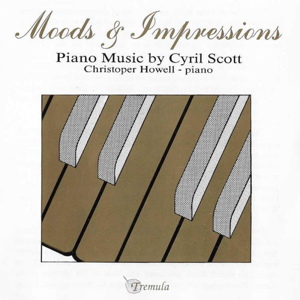
Cyril Scott (1879-1970)
Moods & Impressions
Christopher Howell (piano)
rec. 1993, Regson Studios, Milan, Italy
Tremula Records TREM 104-2 [65]
Thirty-two years late, I have had an opportunity to review this excellent disc of Cyril Scott’s music. Since 1993, there have been major developments in Scott’s solo piano discography, above all Leslie De’Ath’s five-volume survey of a huge portion of his piano music on Dutton Epoch. There is the 2005 two-CD edition of the Complete Sonatas and other works for piano played by Michael Schäfer on Genuin (GEN 85049), and Nino Gvetadze’s 2019 imaginative selection on Challenge Classics (CC72819).
Prior to Christopher Howell’s offering, Dennis Hennig released in 1992 an attractive recital on Etcetera Records (KTC 1132). This was to have been the first volume of a “complete” edition. Sadly, Hennig died shortly afterwards. The same year, Marthanne Verbit included the Sonata No.1, the Danse Negre and Lotusland on her Past Futurists album on Albany Records (Troy 070). Fifty-one years ago, she released these three works on vinyl, coupled with the Five Poems (Genesis GS 1049). There have been others.
Howell’s recital opens with Six Pieces published in 1903, but probably dating from Scott’s time in Frankfurt as a student. This pleasant “salon” music explores a variety of moods. There is no logical connection between these charming pieces. I especially warmed to the Folksong and the bubbly Scherzino.
The Two Pierrott Pieces have often been recorded. Scott wrote them when was living in Liverpool. The first, Pierrott triste, is based on a tonal structure, but overlaid with complex chromaticism. The second, Pierrot gai with its harmonic waywardness, added note chords and a diatonic main theme provides a good contrast. It is interesting to recall that Scott played them to Gabriel Fauré, who was quite complimentary. They were never to meet again. Howell brings all the emotion these lovely numbers require: sadness, introspection in the former and coquetry and vivacity in the latter.
Sea-Marge was dedicated to the American-born British financier and philanthropist Sir Edgar and his wife Lady Spayer. Cyril Scott has developed impressionist harmonies, extended tonality and even nods towards minimalism in this evocative sea-piece. The title implies “at the edge of the sea or river, where the waves break in the shore – ‘marge’ is an archaic word for ‘margin’.
Rudyard Kipling’s The Jungle Book may spark debate today, but it remains rewarding to read and was highly regarded in Scott’s time. His Impressions from the Jungle Book, a five-movement piano suite, were inspired by Kipling’s text. They sometimes appear naïve, but often include striking imagery, like the Stravinsky-ian Dance of the Elephants and the sinuous Rikki-Tikki-Tavi and the Snake. Morning Song of the Jungle, however, is not programmatic. It is a serene character piece, evoking tranquil sunrises – whether in India’s jungles or by the misty Mersey at New Brighton.
Cyril Scott’s two pot-boilers are Lotus Land and Rainbow Trout. Both could be defined as impressionistic. Christopher Howell has wisely chosen to omit the former, as there are dozens of recordings of this piece. Rainbow Trout magically captures the vigorous, erratic movements of this delicious fish, complete with sparkling arpeggios and gentle melodies that paints a vivid picture of a glistening stream and the trout’s progress.
The Little Russian Suite was intended as “teaching music”, but a look at the score suggests that it is no cinch. There is little that is Russian here, save in the opening Air, where Scott quotes a tune from the finale of Tchaikovsky’s Serenade in C for strings (cited De’Ath, line notes CDLX 7183). The Siberian Waltz seems to me a “souped up” salon piece. The final Dance is more like a passacaglia than a turn around the ballroom.
There are nods towards the Billy Mayerl style of piano playing in the First Bagatelle with its subtle swing and metric irregularities. Yet Mayerl did not really get into his stride until the 1920s.
The first of Moods, Sadness, is introverted and seems to come to a halt every so often. Conversely, there are delightful spread chords to add to the interest. Lassitude is equally reserved. The last, Energy, is powerful and vigorous. Moods needs to be played as a set.
The Butterfly Waltz was published by Schott. Leslie De’Ath has suggested that this is a parody of then-fashionable salon and ballroom music. Equally tongue in cheek is the Inclination à la Danse which would appear to nod to Carl Maria von Weber. The final track on this disc is the delightfully romantic Valse Sentimentale with its cocktail piano atmosphere.
Christopher Howell is well known for his explorations of British piano music: complete editions of Charles Villiers Stanford and Alexander Mackenzie, and the ongoing survey of Charles Hubert Hastings Parry. He does not ignore continental composers. There are albums of Debussy’s Preludes and Haydn’s Sonatas.
The performance is splendid, and the recording is good. The adequate liner notes could have given more detailed information/analysis of each piece.
This essential disc for all Cyril Scott enthusiasts predates the massive cycle by Leslie De’Ath by some ten years. As an enjoyable selection of the composer’s music, it has not been superseded.
John France
Availability: Tremula BirnamContents
Six Pieces, op.4 (1903)
Two Pierrot Pieces, op.35 (1904)
Sea-Marge: Meditation (1914)
Impressions from the Jungle Book (1912)
Rainbow Trout (1916)
Butterfly Waltz (1915)
A Little Russian Suite (1916)
First Bagatelle (1919)
Moods (1922)
Inclination à la Danse (1922)
Valse Sentimentale (1929)


















